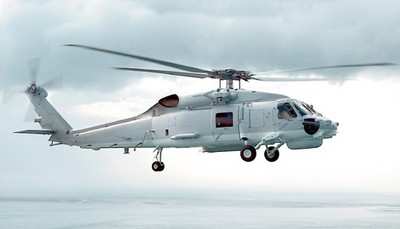Mon, Oct 18, 2010
Boost To Airborne Anti-Submarine Warfare
 Two contracts totaling $115.7 million have been awarded to
Raytheon for the AN/AQS-22 Airborne Low Frequency Sonar (ALFS), the
primary undersea warfare sensor for the U.S. Navy's MH-60R
multimission helicopter. The contracts were awarded by Naval Air
Systems Command and Defense Logistics Agency Aviation Strategic
Acquisition.
Two contracts totaling $115.7 million have been awarded to
Raytheon for the AN/AQS-22 Airborne Low Frequency Sonar (ALFS), the
primary undersea warfare sensor for the U.S. Navy's MH-60R
multimission helicopter. The contracts were awarded by Naval Air
Systems Command and Defense Logistics Agency Aviation Strategic
Acquisition.
ALFS provides critical undersea warfare mission support
capabilities, including submarine detection, tracking,
localization, classification, acoustic intercept, underwater
communication and environmental data collection.
Under the first contract, valued at $59.7 million, Raytheon
Integrated Defense Systems will manufacture, integrate, test and
deliver ALFS systems. The company will also provide data and
weapons replaceable assemblies for systems under test as well as
helicopter maintenance trainer assets. The second contract, for $56
million, provides for spares for fleet-deployed systems.
"ALFS provides an essential capability, the centerpiece of our
airborne anti-submarine warfare mission," said U.S. Navy Rear
Admiral Steven R. Eastburg, program executive officer, Air ASW,
Assault & Special Mission. "Working in tandem with our other
battlegroup assets, the versatility and effectiveness of ALFS
delivers our first line of defense against the threat of enemy
submarines."

MH-60R File Photo
The system's performance and capabilities were tested and proved
during two recent U.S. Navy undersea warfare exercises. The first
was conducted by the John C. Stennis Carrier Strike Group in the
Western Pacific Ocean. ALFS was deployed as the primary
anti-submarine warfare sensor onboard the MH-60R helicopter,
charged with defending the surface ships before the submarines
could come within range to launch an attack. According to Navy
officials, the carrier strike group successfully detected all
exercise submarines during the first deployment. The second
exercise is currently underway with the Abraham Lincoln Carrier
Strike Group.
More News
From 2023 (YouTube Version): Legacy of a Titan Robert (Bob) Anderson Hoover was a fighter pilot, test pilot, flight instructor, and air show superstar. More so, Bob Hoover was an i>[...]
Get The Latest in Aviation News NOW on Instagram Are you on Instagram yet? It's been around for a few years, quietly picking up traction mostly thanks to everybody's new obsession >[...]
Aero Linx: B-52H Stratofortress The B-52H Stratofortress is a long-range, heavy bomber that can perform a variety of missions. The bomber is capable of flying at high subsonic spee>[...]
Altimeter Setting The barometric pressure reading used to adjust a pressure altimeter for variations in existing atmospheric pressure or to the standard altimeter setting (29.92).>[...]
"Knowing that we play an active part in bettering people's lives is extremely rewarding. My team and I are very thankful for the opportunity to be here and to help in any way we ca>[...]
 Classic Aero-TV: Remembering Bob Hoover
Classic Aero-TV: Remembering Bob Hoover ANN FAQ: Follow Us On Instagram!
ANN FAQ: Follow Us On Instagram! ANN's Daily Aero-Linx (05.15.24)
ANN's Daily Aero-Linx (05.15.24) ANN's Daily Aero-Term (05.15.24):Altimeter Setting
ANN's Daily Aero-Term (05.15.24):Altimeter Setting Aero-News: Quote of the Day (05.16.24)
Aero-News: Quote of the Day (05.16.24)




